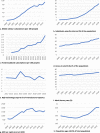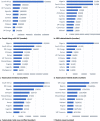Mapping digital health ecosystems in Africa in the context of endemic infectious and non-communicable diseases
- PMID: 37237022
- PMCID: PMC10213589
- DOI: 10.1038/s41746-023-00839-2
Mapping digital health ecosystems in Africa in the context of endemic infectious and non-communicable diseases
Abstract
Investments in digital health technologies such as artificial intelligence, wearable devices, and telemedicine may support Africa achieve United Nations (UN) Sustainable Development Goal for Health by 2030. We aimed to characterize and map digital health ecosystems of all 54 countries in Africa in the context of endemic infectious and non-communicable diseases (ID and NCD). We performed a cross-national ecological analysis of digital health ecosystems using 20-year data from the World Bank, UN Economic Commission for Africa, World Health Organization, and Joint UN Programme on HIV/AIDS. Spearman's rank correlation coefficients were used to characterize ecological correlations between exposure (technology characteristics) and outcome (IDs and NCDs incidence/mortality) variables. Weighted linear combination model was used as the decision rule, combining disease burden, technology access, and economy, to explain, rank, and map digital health ecosystems of a given country. The perspective of our analysis was to support government decision-making. The 20-year trend showed that technology characteristics have been steadily growing in Africa, including internet access, mobile cellular and fixed broadband subscriptions, high-technology manufacturing, GDP per capita, and adult literacy, while many countries have been overwhelmed by a double burden of IDs and NCDs. Inverse correlations exist between technology characteristics and ID burdens, such as fixed broadband subscription and incidence of tuberculosis and malaria, or GDP per capita and incidence of tuberculosis and malaria. Based on our models, countries that should prioritize digital health investments were South Africa, Nigeria, and Tanzania for HIV; Nigeria, South Africa, and Democratic Republic of the Congo (DROC) for tuberculosis; DROC, Nigeria, and Uganda for malaria; and Egypt, Nigeria, and Ethiopia for endemic NCDs including diabetes, cardiovascular disease, respiratory diseases, and malignancies. Countries such as Kenya, Ethiopia, Zambia, Zimbabwe, Angola, and Mozambique were also highly affected by endemic IDs. By mapping digital health ecosystems in Africa, this study provides strategic guidance about where governments should prioritize digital health technology investments that require preliminary analysis of country-specific contexts to bring about sustainable health and economic returns. Building digital infrastructure should be a key part of economic development programs in countries with high disease burdens to ensure more equitable health outcomes. Though infrastructure developments alongside digital health technologies are the responsibility of governments, global health initiatives can cultivate digital health interventions substantially by bridging knowledge and investment gaps, both through technology transfer for local production and negotiation of prices for large-scale deployment of the most impactful digital health technologies.
© 2023. The Author(s).
Conflict of interest statement
V.C.M. has received investigator-initiated research grants (to the institution) and consultation fees (both unrelated to the current work) from Eli Lilly, Bayer, Gilead Sciences, and ViiV. M.K.A. has received investigator-initiated research grants to the institution from Merck and consultation fees (both unrelated to the current work) from Eli Lilly and Bayer. All other authors report no potential conflicts.
Figures






References
-
- Global Burden of Disease Health Financing Collaborator Network. Health sector spending and spending on HIV/AIDS, tuberculosis, and malaria, and development assistance for health: progress towards Sustainable Development Goal 3. Lancet. 2020;396:693–724. doi: 10.1016/S0140-6736(20)30608-5. - DOI - PMC - PubMed
Grants and funding
LinkOut - more resources
Full Text Sources

